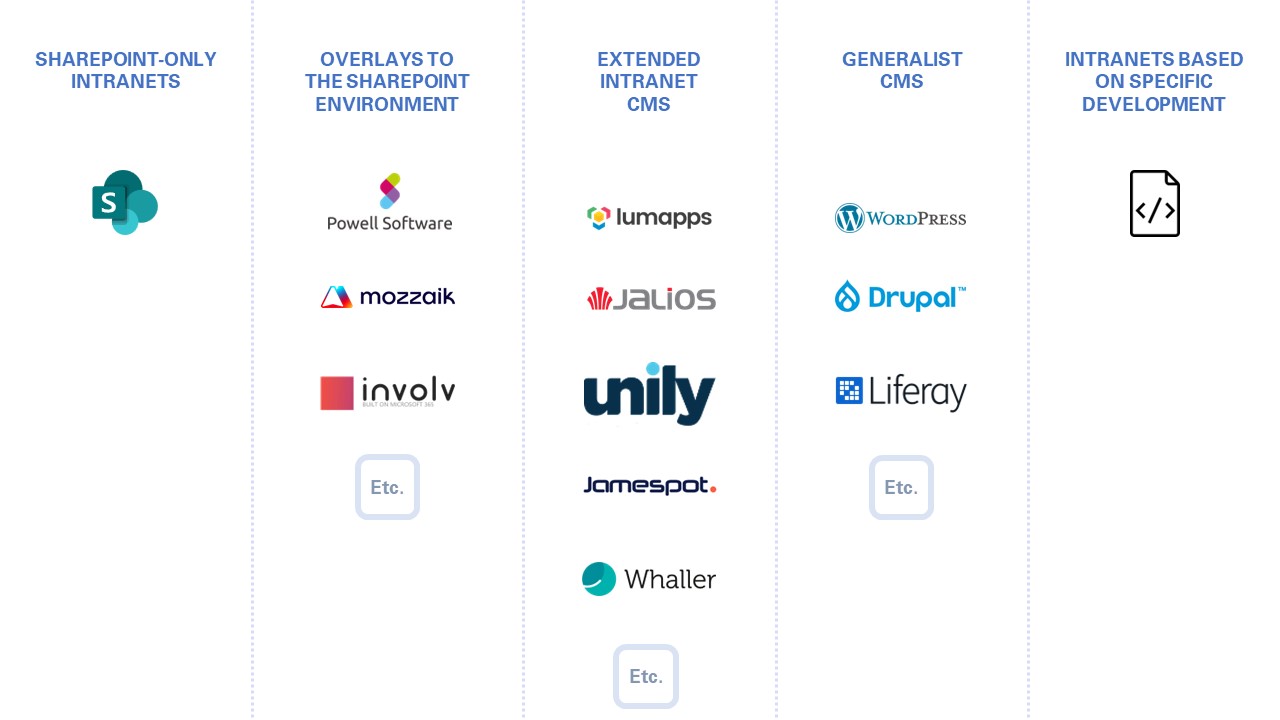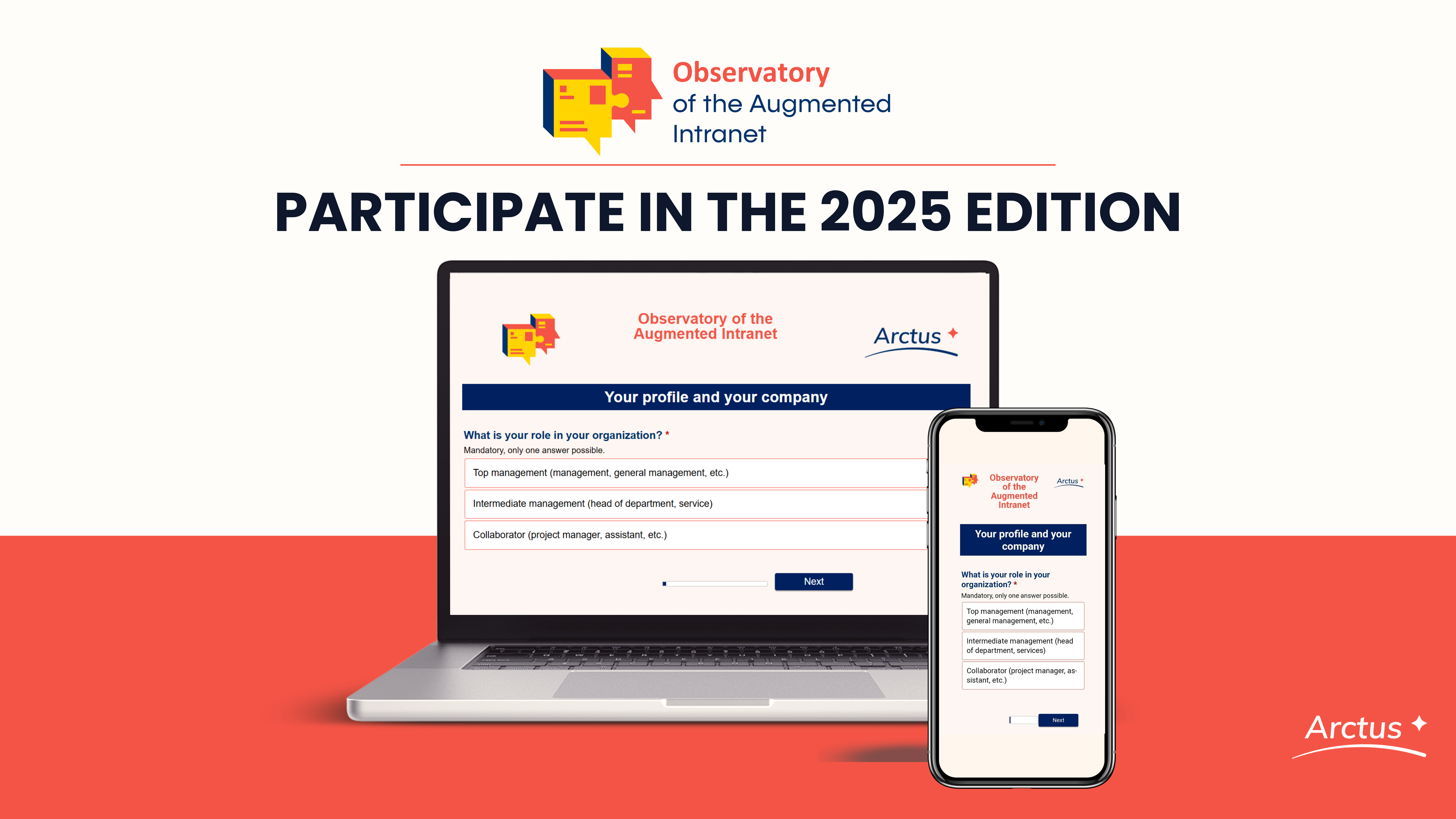ENGAGEMENT DRIVERS: FUNCTIONAL RICHNESS AND SPECIALIZED CMS TRANSFORM THE USER EXPERIENCE

9 November 2023

Why are users of certain organizations' intranets more satisfied than others? Is it possible to prioritize the projects to be carried out to maximize user satisfaction?
After delving into the links between editorial strategy and user satisfaction, let's now turn our attention to the impacts of technical choices. Do modern and feature-rich intranets genuinely bring more satisfaction to users? If you are responsible for Internal Communication, HR, or IT, these results will undoubtedly help you guide your decisions and persuade your stakeholders. Some analyses may confirm what you already knew, but others may surprise you!
Digital Workplace and Employee Experience (EXP): the winning choice compared to traditional intranets.
First, we looked into how intranets were presented or perceived by employees. Do organizations refer to them as "Digital Workplace," "Collaborative or Community Intranet," "Employee Experience Platform," or simply as a traditional information and communication intranet? And most importantly, what is the connection between this positioning and user satisfaction?
The results indicate that while information and communication intranets are the most commonly deployed, they appear to provide the least satisfaction. Indeed 69 % of respondents with a traditional intranet say that their users are dissatisfied (and only 14% are satisfied). In contrast, "Digital Workplace" or "Employee Experience Platform" type systems provide the highest level of satisfaction, with 51% satisfied users (and only 26% dissatisfied).
For more details on the typology of intranets, please refer to the glossary in the appendix of the observatory report!
Choosing a specialized intranet CMS pays off!
A Content Management System (CMS) is software that allows for the creation, management, and updating of web environments (internal or external) without the need for technical expertise. The vast majority of operational intranets are built on a CMS, typically provided by a software publisher.
Regarding intranets, CMS can be categorized into five main categories:

The intersection of this data with user satisfaction clearly indicates that while intranets based solely on SharePoint are the most widely deployed, it is in these organizations that users are the least satisfied. Furthermore, intranets based on specialized intranet CMSs (SharePoint overlays or extended intranet CMSs) are the ones that achieve the highest level of user satisfaction! Finally, the observatory confirms that organizations that have opted for custom development for their intranet generally perceive their users as less satisfied on average.
Nevertheless, beware of misinterpretations. In all five categories, we find organizations where users are satisfied and others where they are not. This means that all CMSs can provide relevant solutions depending on the contexts, expectations, and needs of users. The key is to make an informed choice when selecting the technical solution for your next redesign!
FEATURE-RICH PLATFORM ARE POPULAR!
To measure the impact of functional richness on user satisfaction, we cross-referenced this satisfaction index with the question, "What are the major features available in your internal digital system?"
19 features were listed, with some being quite common in intranets (such as likes, directory, or search engine), and others being more advanced (like idea sharing, meeting facilitation tools, or Business Intelligence).
Then, we categorized respondents into four groups based on the number of features directly accessible in their intranet: Less than 5, between 5 and 10, between 10 and 15, or more than 15. This yielded the following result:
As we can see in this table, the more respondents report having features in their intranet, the more they believe that users in their organization are satisfied. The average score varies from 6/10 for intranets with fewer than 5 features to 7.8/10 for intranets offering 15 features or more! By offering a wide variety of options, the intranet is better equipped to meet the needs of employees and enhance their productivity, which reinforces employees' positive perception of this tool.

A PLATFORM THAT NEEDS TO BE RENEWED TO MAINTAIN ITS PERFORMANCE, WHILE COMMITTING TO A LONG-TERM APPROACH
Finally, it is quite clear that the older the date of the last overhaul of the internal digital system, the greater the number of dissatisfied users. 59% of users of intranets over 7 years old are dissatisfied, compared with only 35% if the intranet is less than 3 years old.
However, it often takes time to put in place a comprehensive intranet that perfectly meets the needs of the various business areas and offers a complete user experience. An overhaul allows you to overhaul the content architecture and improve the design and interface, but it often takes several years to address the needs of all users, identify specific use cases and support the change.
In fact, our analysis shows that 33% of respondents with a system older than 7 years express satisfaction, demonstrating that some organizations invest over the long term and succeed in evolving their system to offer a satisfactory experience.
This is the case, for example, with EDF's intranet. Their intranet, launched in 2011, has undergone several evolutions to constantly adapt to emerging business needs. Today, EDF continues to invest more in user support than in functional evolutions, as Nathalie Dudragne, Intranet Project Manager, tells us: Today, EDF continues to invest more in user support than in functional upgrades, as Nathalie Dudragne, Intranet Project Manager, explains:
"We have a real promote our intranet than upgrading our Intranet. It is already very rich (in terms of content and functions), but usage levels are not optimal. We are also seeing the emergence of satellite projects from other departments and making a direct duplication with the Group Intranet. It is therefore important for us to centralising usage as much as possible."
"Intranet and User Satisfaction: What Are We Talking About?"
For this 2023 edition of the Intranet & Digital Communication Observatory, we asked a unique question: 'In your opinion, what is the average satisfaction level of the users of your organization's intranet?' Respondents were asked to rate this on a scale from 1 to 10.
1st observation: The overall average score is 6.5/10. If this score aligns with what we observe in our client surveys before a redesign project, it generally confirms that the intranets currently in place in organizations generally provide mixed satisfaction.
To add some depth to our analysis while keeping it readable, we chose to make groupings:
- Organizations in which the average user level is rated from 1 to 6 are grouped under the label "Dissatisfied."
- Those between 8 and 10 are referred to as "Satisfied."
- Those who responded with 7 are considered "Neutral."

Cross-tabulations: a way to visualize correlations.
In our surveys, we analyze in detail the cross-tabulation of questions with each other. This allows us to make sense of correlation factors. In the example of user satisfaction, it allows us to demonstrate, for instance, that in the Services sector, 42% of organizations consider intranet users to be satisfied, compared to only 13% in the Administration sector.
Warning: This approach does not demonstrate causality but rather correlation effects. It is not a predictive model and does not guarantee that implementing a specific initiative, feature, or rule will result in a particular increase in satisfaction. This remains inherent to each organization.
That's why it's essential to listen to YOUR employees and provide CUSTOMIZED responses! Contact us for that!


